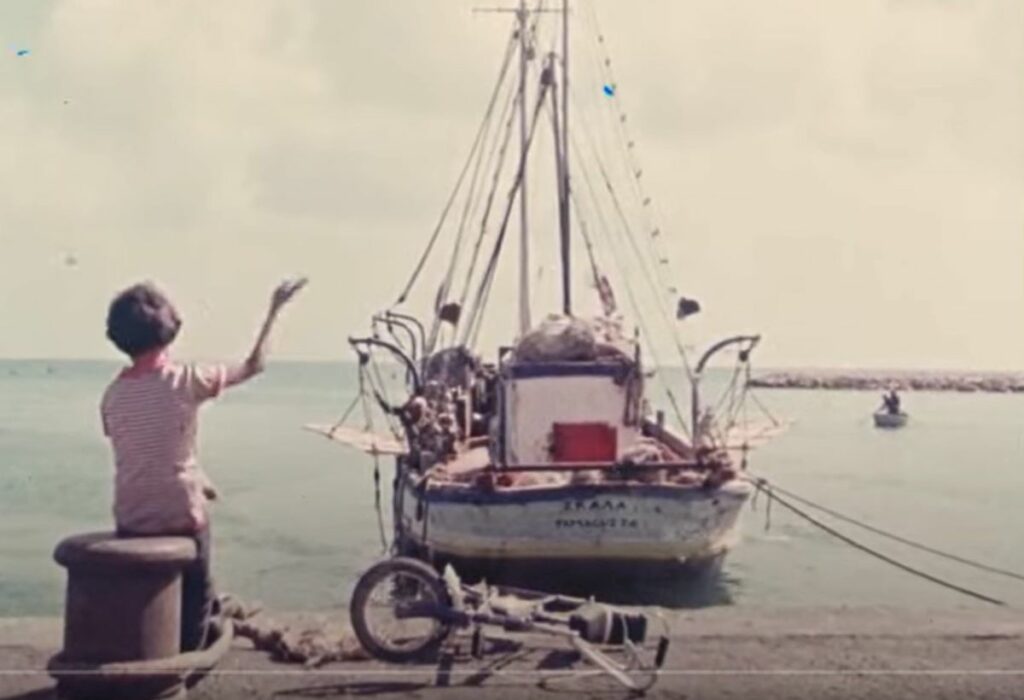Lost Film on Cypriot Plight Resurfaces: Professor’s Efforts Unveil Powerful Narrative… “A Boy Named Panayótis” (watch the powerful video)

A Boy Named Panayotis (1974). Photo via video, GOARCH Archives
NEW YORK–Thought to have been lost, a powerful film that brought awareness to the American public of the plight of the Cypriot refugees following the 1974 invasion of their home has resurfaced. The film’s reemergence is credited to the relentless determination of Professor Fevronia Soumakis and Bishop Spyridon of Amastris (née Fr. Spencer Kezios).
While working on a publication that chronicles the educational efforts of the Greek Orthodox Church in America as part of a greater Greek-American movement for Cyprus in the mid-seventies, Professor Soumakis, who is an adjunct assistant professor at Queens College-CUNY, found a reference to the film while carrying out research in the Archdiocesan Archives in New York City. “I wanted to know more about it, but there was not a copy in the Archives.”
Later, Professor Soumakis’ research took her to Cyprus where she found several documents in the National Archives of Cyprus hat made references to the film. Once again, however, the film was not part of the Cypriot Archival collection.
The Archives did provide Soumakis with one helpful clue: that production of the film was spearheaded by one Fr. Spencer Kezios. Soumakis reached out to the Director of the Archdiocesan Archives, Aristomenis Papadimitriou, for more information on “Fr. Spencer” when she could not locate him in the Archdiocesan Directory. Little did she know, “Fr. Spencer” was now known as “Bishop Spyridon of Amastris.”
- When the Archives reached Bishop Spyridon, His Grace was enthusiastic to share his experience of its production and reception—and delighted to share that he retained a personal copy. “I have the original on 8mm film—but I also have it on my computer.”
On July 19, 2024, The Archdiocesan Archives received a digital copy, and made the film available to the public on the following day, July 20, which marked the somber fiftieth anniversary of the invasion. It can be found on the GOARCH Archives YouTube Channel.
“Archbishop Iakovos sent me on a mission to Cyprus, instructing me to produce a film and a folkloric performance to tour the US and bring the American public awareness of Cyprus, not just of the invasion, but about the country’s history and its culture.”
Professor Soumakis’ current research, which will be presented at the University of Chicago this fall, focuses on this important educational initiative of the Greek Orthodox Archdiocese of America. “
The educational curriculums produced by the Archdiocese and its Greek Schools were drawn into the Greek-American effort at the national level—an effort spearheaded by the Archdiocese, to educate both Greeks and Americans alike on the rich historical and cultural significance of Cyprus, in addition to making the public aware of the violent invasion and its international ramifications.”
Directed and produced by Tony Frangakis, “A Boy Named Panayótis” documents the true story of a young boy who was one of 250,000 victims of the invasion and illegal occupation of Cyprus that began on July 20, 1974 and continues to this day.
Set against the backdrop of post-invasion Cyprus, this compelling film rawly portrays those displaced from their homes in the occupied North. No actors or sets were used in its making. Every scene features real encampments and Cypriot refugees and captures the haunting reality of individuals violently uprooted by Turkish military forces and forbidden from returning to their homes.
- The story was conveyed by an actual refugee boy, who detailed his experience of the invasion and its aftermath. His immediate family members were numbered among the several thousand missing. The real Panayotis, however, did not appear in the film.
Bishop Spyridon explained that the film was not produced and presented as a stand-alone piece. It was a piece in a larger show that included a folkloric performance by the Cypriot national dance troupe, The Sousta Dancers.
“It was important to place the film within the context of Cypriot history, music, and culture. We brought the best dancers from Cyprus to perform in thirty cities in the US. The best dancer was actually conscripted at the time, and Archbishop Makarios, Cyprus’ president, granted him leave to perform in the US.”
The performance portrayed key aspects of Cypriot life, including the important place of Orthodox Christianity on the island, showing a Cypriot wedding, interrupted by the violence of the invasion. It achieved its objective, raising awareness an a substantial amount of money to assist with the refugee crisis.
These efforts also had significant political impact. As Professor Alexander Kitroeff has written, “the widespread mobilization by the Greek American community following the Turkish invasion and occupation…was successful in persuading Congress to impose an embargo on arms sales to Turkey. This happened over Henry Kissinger’s strenuous objections.
- The embargo lasted until 1978 but it remains a rare instance of Congress shaping U.S. foreign policy due to pressure from an American ethnic group.”
Kitroeff laments that awareness of Cyprus fallen off the radar screen of U.S. foreign policy. “There is no public voice to remind them of Cyprus’ relevance as a longstanding violation of the norms of international relations,” he said, adding, “there are a number of Greek-American organizations lobbying either directly or indirectly in Washington, D.C. about Cyprus and other Hellenic issues.
But they are focused on policymakers, not on opinion makers or public opinion.” Kitroeff hopes that as Greek-Americans commemorate the fiftieth anniversary of the invasion this summer, they will come up with creative ways to make America remember Cyprus.
Ακολουθήστε τη HELLAS JOURNAL στη NEWS GOOGLE